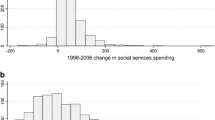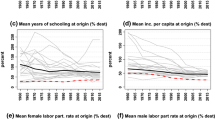Abstract
Using a panel of OECD countries, we show that immigration systematically alters the composition of public spending in the destination country. To mitigate bias from the endogenous sorting of immigrants, we use an IV estimation strategy. The instrument is constructed by estimating a bilateral migration model for 24 destination and 208 source countries. We find that the host country responds to the increase in immigrants by adjusting various expenditures, such as by reallocating resources from social welfare to national defense and public order. Our findings imply that (1) immigration affects policy outcomes in areas with a low ethnic or redistributive dimension and (2) immigration may have an insubstantial effect on the total size of government.
Similar content being viewed by others
Notes
In recent decades, the main sources of migration inflows to OECD countries changed from labor migration to refugees or family reunion immigrants from less-developed countries (Chiswick and Hatton 2003). These latter groups often have lower skills and higher unemployment rates than the natives (Pedersen et al. 2008). Thus, (unskilled) immigrants are overrepresented among welfare-dependents in welfare states (Borjas and Hilton 1996; Borjas 1999; Boeri 2010; Hansen and Lofstrom 2003).
In the Italian national elections, for instance, immigration inflows increased votes for the center-right coalition with a political platform less favorable to immigrants and these changes in voters’ preferences were partly driven by competition for public services (Barone et al. 2016).
General government expenditures by function (COFOG) are not available for Canada, Chile, Iceland, Mexico, New Zealand and Turkey. Data on bilateral migration stock are unavailable for Estonia, Ireland, Israel and Slovenia.
In addition, countries define immigrants differently. For instance, some OECD countries define immigrants by country of birth (i.e., foreign-born population), while others define immigrants by citizenship or self-reported nationality (i.e., foreign population) (see Pedersen et al. 2008). The former definition includes foreign-born (naturalized) citizens, while the latter definition excludes foreign-born citizens but includes native-born (unnaturalized) foreigners. Depending on the system of citizenship and naturalization, each definition may overestimate or underestimate the number of immigrants (OECD International Migration Outlook 2016).
We measure political corruption using the Corruption Perceptions Index by Transparency International. The index measures the extent to which corruption is perceived to exist among public officials on a reverse scale from 0 (least corrupt) to 10 (most corrupt).
Borjas (1999) shows that immigrant welfare recipients are more heavily clustered in high-benefit US states than those who do not receive welfare. Using data from Norwegian local governments, Fiva (2009) also finds that welfare policy affects the residential choices of welfare recipients. On the contrary, using microdata from the National Longitudinal Survey of Youth, Levine and Zimmerman (1999) find little evidence that welfare benefits have a significant effect on migration decisions across US states.
Both distance and cultural data were taken from the CEPII Gravity Dataset.
Aleksynska and Tritah (2015) control for destination country income in the bilateral migration equation because their main equation examines the effect of immigration on the destination country income. In any case, the causal effect of supply-side determinants is not our main interest.
See Kenny and Winer (2006) for the case of tax revenue.
Tabellini (2020) finds that the US immigration wave in the early twentieth century caused the reduction in public spending on the services that would benefit poorer immigrants more than the native residents.
Specifically, Chevalier et al. (2018) find that high-inflow cities shifted their spending toward social welfare and away from local infrastructure and schools. The potential reason is that those migrants, unlike most international migrants, were German citizens with full voting rights and were poorer than the average West Germans.
Similarly, Luttmer (2001) finds that respondents increase their support for redistribution as the share of welfare recipients from their own ethnic groups increases.
Countries respond to political instability by increasing military spending that will deter internal rebellion and conflicts (Gebremedhin and Mavisakalyan 2013).
Governments typically determine the current year’s budget (e.g., 2008) in the prior year (i.e., 2007).
We aggregate bilateral migration stocks of OECD (non-OECD) source countries to generate an OECD immigrants (non-OECD immigrants) variable for a given destination country.
In general, immigrants from non-OECD origin countries are more likely to be unemployed (11.3%) than those from OECD origin countries (8.7%) (OECD Database on Immigrants in OECD Countries). This difference also holds for all levels of education (tertiary, secondary and primary).
In column 2, the coefficient of the simple right-wing government term (0.789) indicates the impact of having a right-wing government if the immigration share is 0. Evaluated at the mean value of immigrant share, the marginal effect of a right-wing government dummy becomes negative and significant (not reported).
References
Aleksynska, M., & Tritah, A. (2015). The heterogeneity of immigrants, host countries’ income and productivity: A channel accounting approach. Economic Inquiry, 53(1), 150–172.
Alesina, A., & La Ferrara, E. (2005). Ethnic diversity and economic performance. Journal of economic literature, 43(3), 762–800.
Alesina, A., Miano, A., & Stantcheva, S. (2018). Immigration and redistribution. NBER working paper No. 24733.
Alesina, A., Murard, E., & Rapport, H. (2019). Immigration and preferences for redistribution in Europe. NBER Working Paper No. 25562.
Barone, G., D’Ignazio, A., de Blasio, G., & Naticchioni, P. (2016). Mr. Rossi, Mr. Hu and politics. The role of immigration in shaping natives’ voting behavior. Journal of Public Economics, 136, 1–13.
Bianchi, M., Buonanno, P., & Pinotti, P. (2012). Do immigrants cause crime? Journal of the European Economic Association, 10(6), 1318–1347.
Bell, B., Fasani, F., & Machin, S. (2013). Crime and immigration: evidence from large immigrant waves. Review of Economics and Statistics, 94(5), 1278–1290.
Betts, J. R., & Fairlie, R. W. (2003). Does immigration induce ‘native flight’from public schools into private schools? Journal of Public Economics, 87(5–6), 987–1012.
Boeri, T. (2010). Immigration to the Land of Redistribution. Economica, 77(308), 651–687.
Böheim, R., & Mayr, K. (2005). Immigration and public spending. IZA Discussion Paper No., 1834, 2005.
Borjas, G. J. (1999). Immigration and welfare magnets. Journal of Labor Economics, 17(4), 607–637.
Borjas, G. J., & Hilton, L. (1996). Immigration and the welfare state: Immigrant participation in means-tested entitlement programs. The Quarterly Journal of Economics, 111(2), 575–604.
Chevalier, A., Elsner, B., Lichter, A., & Pestel, N. (2018). Immigrant voters, taxation and the size of the welfare state. IZA discussion paper No. 11725.
Chiswick, B., & Hatton, T. J. (2003). International migration and the integration of labor markets. In Globalization in historical perspective (pp. 65–120). University of Chicago Press.
Coen-Pirani, D. (2011). Immigration and spending on public education: California, 1970–2000. Journal of Public Economics, 95(11), 1386–1396.
Dahlberg, M., Edmark, K., & Lundqvist, H. (2012). Ethnic diversity and preferences for redistribution. Journal of Political Economy, 120(1), 41–76.
Eger, M. A. (2009). Even in Sweden: the effect of immigration on support for welfare state spending. European Sociological Review, 26(2), 203–217.
Facchini, G., & Mayda, A. M. (2009). Does the welfare state affect individual attitudes toward immigrants? Evidence across countries. The Review of Economics and Statistics, 91(2), 295–314.
Fiva, J. H. (2009). Does welfare policy affect residential choices? An empirical investigation accounting for policy endogeneity. Journal of Public Economics, 93, 529–540.
Gebremedhin, T. A., & Mavisakalyan, A. (2013). Immigration and political instability. Kyklos, 66(3), 317–341.
Gerdes, C. (2011). The impact of immigration on the size of government: Empirical evidence from Danish municipalities. Scandinavian Journal of Economics, 113(1), 74–92.
Halla, M., Wagner, A. F., & Zweimüller, J. (2017). Immigration and voting for the far right. Journal of the European Economic Association, 15(6), 1341–1385.
Hansen, J., & Lofstrom, M. (2003). Immigrant assimilation and welfare participation do immigrants assimilate into or out of welfare? Journal of Human Resources, 38(1), 74–98.
Hessami, Z. (2014). Political corruption, public procurement and budget composition: Theory and evidence from OECD countries. European Journal of Political Economy, 34, 372–389.
Hopkins, D. J. (2009). The diversity discount: When increasing ethnic and racial diversity prevents tax increases. The Journal of Politics, 71(1), 160–177.
Hopkins, D. J. (2011). National debates, local responses: the origins of local concern about immigration in Britain and the United States. British Journal of Political Science, 41(3), 499–524.
Jofre-Monseny, J., Sorribas-Navarro, P., & Vázquez-Grenno, J. (2016). Immigration and local spending in social services: evidence from a massive immigration wave. International Tax and Public Finance, 23(6), 1004–1029.
Kenny, L. W., & Winer, S. L. (2006). Tax systems in the world: An empirical investigation into the importance of tax bases, administration costs, scale and political regime. International Tax and Public Finance, 13(2), 181–215.
Lee, S., Lee, D., & Borcherding, T. E. (2016). Ethnic diversity and public goods provision: Evidence from US municipalities and school districts. Urban Affairs Review, 52(5), 685–713.
Levine, P. B., & Zimmerman, D. J. (1999). An empirical analysis of the welfare magnet debate using the NLSY. Journal of Population Economics, 12, 391–409.
Lewer, J. J., & Van den Berg, H. (2008). A gravity model of immigration. Economics Letters, 99(1), 164–167.
Luttmer, E. F. (2001). Group loyalty and the taste for redistribution. Journal of political Economy, 109(3), 500–528.
Mavisakalyan, A. (2011). Immigration, public education spending and private schooling. Southern Economic Journal, 78(2), 397–423.
Mayda, A. M. (2010). International migration: A panel data analysis of the determinants of bilateral flows. Journal of Population Economics, 23(4), 1249–1274.
Nannestad, P. (2007). Immigration and welfare states: A survey of 15 years of research. European Journal of Political Economy, 23(2), 512–532.
OECD. (2016). International migration outlook 2016. Paris: OECD publishing.
Ortega, F., & Peri, G. (2009). The causes and effects of international migrations: Evidence from OECD countries 1980–2005 (No. w14833). National Bureau of Economic Research.
Pedersen, P. J., Pytlikova, M., & Smith, N. (2008). Selection and network effects—Migration flows into OECD countries 1990–2000. European Economic Review, 52(7), 1160–1186.
Potrafke, N. (2008). Political effects on the allocation of public expenditures: Empirical evidence from OECD countries (No. 653). DIW discussion papers.
Potrafke, N. (2011). Does government ideology influence budget composition? Empirical evidence from OECD countries. Economics of Governance, 12(2), 101–134.
Preston, I. (2014). The effect of immigration on public finances. The Economic Journal, 124(580), 569–592.
Razin, A. (2013). Migration into the welfare state: Tax and migration competition. International tax and public finance, 20(4), 548–563.
Razin, A., Sadka, E., & Swagel, P. (2002). Tax burden and migration: a political economy theory and evidence. Journal of Public Economics, 85(2), 167–190.
Shelton, C. A. (2007). The size and composition of government expenditure. Journal of Public Economics, 91(11), 2230–2260.
Soroka, S. N., Johnston, R., Kevins, A., Banting, K., & Kymlicka, W. (2016). Migration and welfare state spending. European Political Science Review, 8(2), 173–194.
Speciale, B. (2012). Does immigration affect public education expenditures? Quasi-experimental evidence. Journal of Public Economics, 96(9), 773–783.
Stichnoth, H., & Van der Straeten, K. (2013). Ethnic diversity, public spending and individual support for the welfare state: A review of the empirical literature. Journal of Economic Surveys, 27(2), 364–389.
Tabellini, M. (2020). Gifts of the immigrants, woes of the natives: Lessons from the age of mass migration. Review of Economic Studies, 87(1), 454–486.
Acknowledgements
This article is based on the first author’s doctoral dissertation at Sungkyunkwan University. We would like to thank an anonymous reviewer, Seok-ju Cho (Kyung Hee University), Woo-Hyung Hong (Hansung Univeristy), Hyunchul Kim, Minseong Kim, Minsoo Park (Sungkyunkwan University), Hee-Seung Yang (Yonsei University) and participants at the meetings of the Korean Association of Public Finance for valuable comments and suggestions.
Author information
Authors and Affiliations
Corresponding author
Rights and permissions
About this article
Cite this article
Kim, D., Lee, D. Immigration and the pattern of public spending: evidence from OECD countries. Int Tax Public Finance 28, 1014–1034 (2021). https://doi.org/10.1007/s10797-020-09638-x
Accepted:
Published:
Issue Date:
DOI: https://doi.org/10.1007/s10797-020-09638-x




